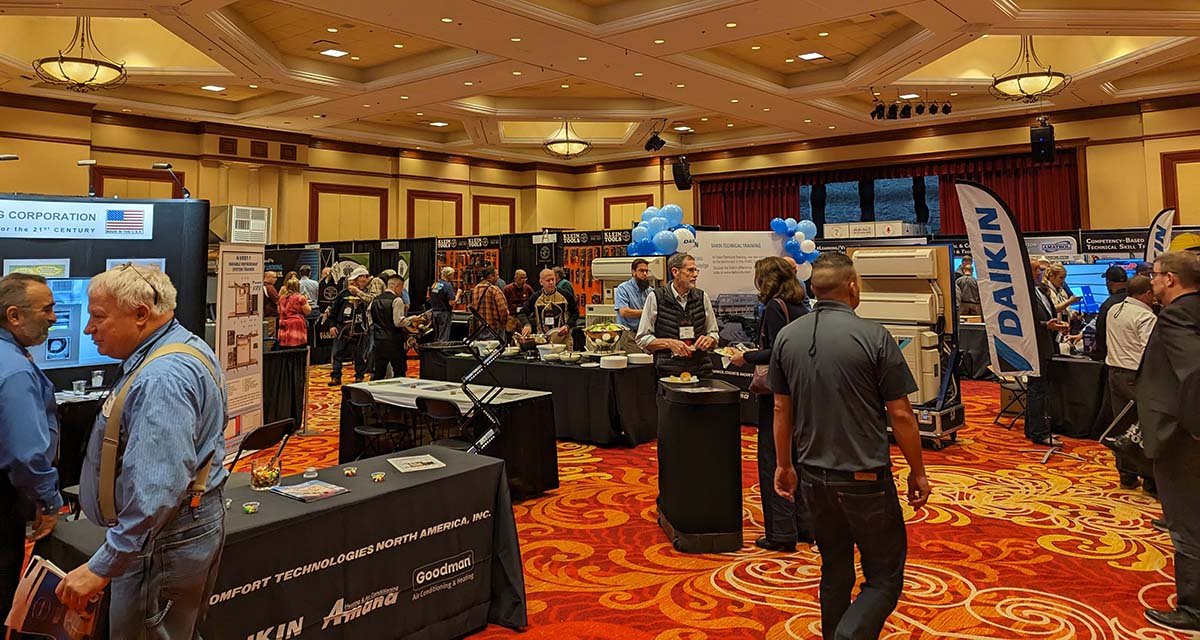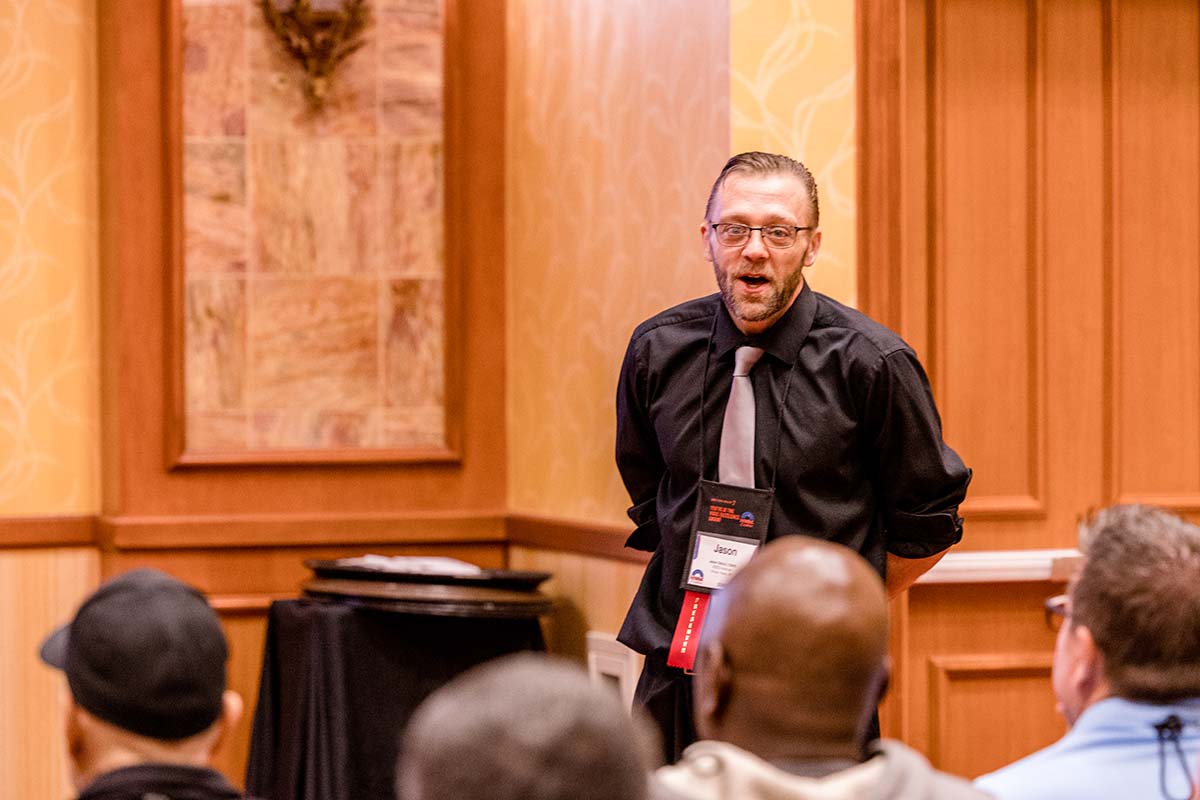The ESCO Group's National HVACR Education Conference, recently held in Las Vegas, featured an extensive number of educational sessions covering a wide range of topics. The annual event included seminars that delved into the hottest topics in the HVACR industry, such as mildly flammable (A2L) refrigerants, federal regulations, cold climate heat pumps, and best practices, among many others.
The well-attended conference provided HVACR professionals with a unique opportunity to learn directly from industry experts. This included those involved in the design, engineering, and development of new equipment, controls, refrigerants, as well as other leaders at the forefront of emerging technologies, regulations, and significant changes that affect the work of HVACR contractors and instructors.

MEET AND MINGLE: Attendees were able to meet and mingle with HVAC manufacturers during the conference. (Staff photo)
Refrigerants
The HFC phasedown and refrigerant transition to lower-GWP refrigerants were definitely on the minds of attendees at the conference. At several educational sessions covering these topics, industry experts discussed how the phasedown — which started last year with a 10% cut in the production of HFCs — would affect the industry. They also provided information about the new A2L refrigerants that are poised to take the place of R-410A in many types of equipment.

PREMIUM PRICE: Jason Obrzut from ESCO Group said that reclaimers have been paying a premium for R-22 and that they will do the same for R-410A. (Courtesy of ESCO Group)
During several sessions, Jason Obrzut, director of industry standards and relations at ESCO Institute and Don Gillis, senior technical trainer at Chemours, answered questions from the audience about A2L refrigerants.
Given the HFC phasedown, one attendee asked about the availability of R-410A going forward. Obrzut said that the recent EPA proposed ruling to limit the GWP in new equipment to 700 or less by 2025 will ultimately free up more refrigerant for the service market.
“We're all competing for the R-410A that’s left on the market. The manufacturers need it to precharge their equipment, and the techs need it for service gas,” he said. “This proposed rule takes the manufacturers out of the game and moves all the refrigerant that they would use over to the service side. We're hoping that if everyone gets on the same page at the same time, that will free up some of the refrigerant for the service side.”
The other important factor going forward will be refrigerant reclaim, said Obrzut. He noted that reclaimers have been paying a premium for R-22 and that they will do the same for R-410A. And the good news is most of the existing R-410A in the field is clean and should command a good price.
“R-22 has multiple EPA SNAP-approved substitutes that can go into that system. When you go to service an R-22 system, you don’t know what’s in there. It’s probably a mixture,” said Obrzut. “There are no substitutes for R-410A, so most of it sitting in these units out there is clean. It's good for reclaiming; it's worth buying.”
Another question concerned whether there would be new rules regarding the transport of A2L refrigerants, given that they are considered to be mildly flammable. Obrzut said that service technicians already drive around with very flammable gases in their trucks and that the Department of Transportation allows up to 440 pounds of these — and A2L — gases to be transported. He added that oxygen and acetylene, which are found in most service trucks, are far more flammable than R-32 and R-454B.
Obrzut noted that DOT also currently requires flammable refrigerant cylinders to be transported in the upright position, but that may be changing.
“If you're living in a state where you're working with A2Ls, they do have to be shipped upright. That is the current law of the land,” said Obrzut. “But in the near future, there will be a petition granted to allow for the horizontal shipping of these tanks. DOT did all kinds of testing on the tanks and showed this was safe, so sometime in the future, DOT will issue a statement that will allow for the horizontal transportation of A2Ls. It's just not there now. So right now, they have to be upright.”
A2L cylinders will also look different, said Gillis, as they will include a left-handed thread and a red band around the top of the cylinder. In addition, A2L cylinders will be equipped with a pressure relief valve that is designed to open and release a small amount of gas, thereby reducing the pressure inside the cylinder before closing back up. This is different than R-410A cylinders, which release their entire contents if the rupture disc bursts.
Safety First
Some attendees at the conference seemed to conflate A3 refrigerants, such as hydrocarbons (e.g., R-290, R-600a), with A2L refrigerants (e.g., R-32, R-454B). Obrzut stated emphatically that there are no hydrocarbons in A2L refrigerants and that systems using these mildly flammable refrigerants will include safety features, such as refrigerant detection systems (RDS). These RDS will be proprietary to the manufacture and each will work a little differently.
“There will be sensors, one at the outdoor coil, one at the indoor coil, and some manufacturers are even providing a third sensor that can go in-duct downstream,” said Obrzut. “Then every 10 or 15 seconds, the RDS will sniff for a leak. If they sense a leak, the unit will shut down and turn on the fans until the refrigerant is diluted enough to stay below the lower flammability level (LFL). These safety mitigations are built in, so they’re already on board.”
He added that risk is also mitigated by limiting the amount of refrigerant charge based on the cubic volume of the installation space. The correct charge size will depend on the unit's capacity, as well as the volume of the air space, which can vary from one installation to another. This will not be a universal number, but technicians can rely on manufacturers to provide a charging chart that specifies the recommended charge based on the system's location, capacity, and cubic volume.
Gillis added that there are two points that he wanted to get across to everyone in the HVACR industry: that there are no hydrocarbons in A2L and that A2L refrigerants cannot be retrofitted into existing A1 equipment. He also said there was no reason to fear the transition to A2L refrigerants.
“Nine out of every 10 cars today have R-1234yf [an A2L refrigerant] in it, which replaced R-134a,” said Gillis. “It's around us already. I don't want people to go out and say the sky is falling. To me, this transition is going to be easier than it was to go from R-22 to R-410A.”



Report Abusive Comment